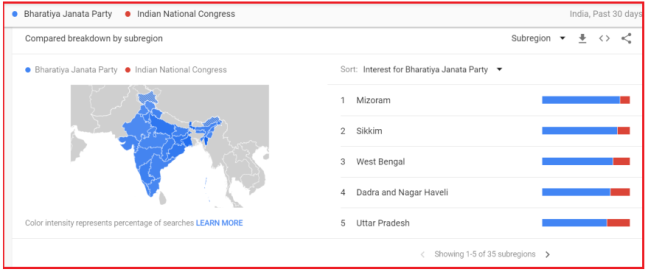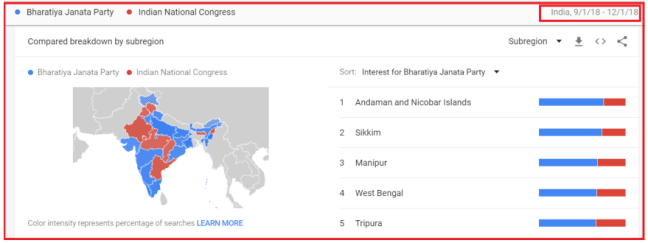In the middle of the Lok Sabha elections, I had written an article looking at Google Trends, which showed the BJP miles ahead of the Congress and the rest of the opposition. On a personality basis, Narendra Modi was even further ahead and Rahul was simply nowhere. And now, it is time to analyse the Delhi elections according to Google Trends.
The election turned out exactly the same way.
Here is what the map looked like in the 30 days before April 24, 2019.

Blue for the BJP and red for the Congress. On April 24, 2019, Google Trends said India was an ocean of blue. How was the Congress going to win when nobody even cared about what they had to say?
I had also pointed out how Google Trends appears to have accurately captured the Congress surge in the three Hindi heartland states in Dec 2018. Just look at the Google Trends map for the period Sept 1, 2018, to Dec 1, 2018.

See how the BJP seems ahead almost all across the Hindi heartland except for Rajasthan, Madhya Pradesh and Chhattisgarh, the three election-bound states.
If Google’s wisdom seems so profound in states with huge rural populations, surely it should be taken even more seriously in Delhi. A purely urban electorate saturated with media and the internet.
So what does the BJP vs AAP comparison look like in the last 30 days in Delhi?

First of all, take a moment to admire just how accurately Google Trends picks up what is going on in the minds of the public. What is that sharp red spike for AAP?
It’s from Jan 14, 2020.
And when did AAP announce its candidates? On Jan 14, 2020, of course! You don’t even have to look that up. Google Trends knows everything.
Read: Google Trends data shows that Indians hardly have any interest in Rahul Gandhi
But other than that, the BJP (blue) dominates over AAP (red) almost uniformly. And you can see that interest in BJP is peaking, rising almost in hockey-stick fashion.
This is bad news for AAP.
Wait! There is an obvious objection and one must address it here. The BJP is a national party, while AAP is not. Perhaps BJP is getting more interest simply because people think about BJP in the context of a much wider range of issues, while AAP only matters in local politics?
So let us see the related searches for BJP in Delhi, according to Google trends.

It is evident that all these searches are related to the state election and not national issues.
So we know two things for sure. First, BJP is getting much more interest in Delhi than AAP is. Second, the interest in BJP is driven primarily by local issues and not national issues.
Now I know there are some opinion poll agencies (with absolutely pathetic track records, I must add) which have projected the Delhi election as some kind of one way victory for AAP. I don’t trust them. I’d rather look at Google Trends data.
Read: Business Standard withdraws article after OpIndia fact-check, when will others show the same ethics?
By now, everyone has noticed that Kejriwal has maintained a safe distance from the CAA issue. He’s stayed away from Shaheen Bagh. In fact, in recent days, top liberals have also been begging with Shaheen Bagh protesters to temporarily withdraw their movement for strategic reasons.
Is Kejriwal confident? I doubt this.
Again, keep in mind that Delhi is a 100% urban environment where media and internet matters a lot. And AAP is media savvy, known to have an extensive online presence. Despite this, Google Trends shows interest in BJP clearly ahead of AAP.
One last thing. AAP is synonymous with Kejriwal. How about we compare BJP vs Arvind Kejriwal?

Again, pretty big and uniform lead for BJP and the gap only widening in the last few days. If you ask me, that’s the classic surge that the winner gets towards the end.



